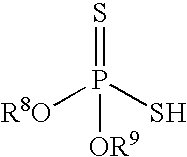Silane additives for lubricants and fuels
a technology of additives and lubricants, applied in the field of lubricants, can solve problems such as limiting the service life of catalytic converters that are used
- Summary
- Abstract
- Description
- Claims
- Application Information
AI Technical Summary
Benefits of technology
Problems solved by technology
Method used
Image
Examples
examples
Anti-Wear Four-Ball Testing
[0086]The anti-wear properties of the silanes in a fully formulated lubricating oil were determined in the Four-Ball Wear Test under the ASTM D 4172 test conditions. The testing for these examples was done on a Falex Variable Drive Four-Ball Wear Test Machine. Four balls are arranged in an equilateral tetrahedron. The lower three balls are clamped securely in a test cup filled with lubricant and the upper ball is held by a chuck that is motor-driven. The upper ball rotates against the fixed lower balls. Load is applied in an upward direction through a weight / lever arm system. Loading is through a continuously variable pneumatic loading system. Heaters allow operation at elevated oil temperatures. The three stationary steel balls are immersed in 10 milliliters of sample to be tested, and the fourth steel ball is rotated on top of the three stationary balls in “point-to-point contact.” The machine is operated for one hour at 75° C. with a load of 40 kilogram...
examples a-s
[0089]The following examples demonstrate the efficacy of the silanes as lubricant additives. They also show a synergistic effect with zinc dialkyldithiophosphate. In addition, they show no harm in corrosion testing.
[0090]
TABLE 2Summary of Anti-wear testing of silanes alone and in combination withZDDP on an equal weight basis - Average resultsFalex 4-BallCameron-PlintAvg. WearCameron-PlintPlate Wear Scar,Scar DiameterAvg. Ball Wearmaximum depthExampleChemical Name(mm)Scar (mm)(μm)A (comparative)ZDDP (1%) 0.454 (11×) 0.437 (18×) 2.33 (18×)B (comparative)ZDDP (0.5%)0.475 (4×)0.594 (5×)11.32 (5×) C (comparative)No Anti-wear 0.800 (10×) 0.743 (22×)17.54 (22×)Single AW (1 wt %)D (invention)(Octyl triethoxy0.643 (3×)0.684 (2×)17.21 (2×) Silane)E (invention)1,2-bis-0.494 (2×)0.589 (2×)10.5 (2×)(triethoxysilyl)ethaneF (invention)bis(3-0.565 (2×)0.706 (2×)6.81 (2×)triethoxysilyl-1-propyl)tetrasulfideG (invention)bis(3-0.517 (2×)0.659 (5×)10.64 (5×) triethoxysilyl-1-propyl)disulfideH (inventio...
examples t -
Examples T-X
Pb & Cu Corrosion Testing
[0091]In TABLE 3 are the results of a Cummins bench test for measuring the degree of Cu and Pb corrosion of an oil formulation. The Cummins bench test is part of the API CH-4 category for diesel engine oils. Four metal coupons (25.4 mm squares) of pure lead, copper, tin, and phosphor-bronze are immersed in 100 mL of oil at 121° C. with air bubbling through (5 L / hr) for 168 hours. The used oil is analyzed for metals and the copper sample is examined for discoloration. The limits for API CH-4 are 20 ppm Cu, 120 ppm Pb, 50 ppm Sn in used oil and 3 max for the ASTM D 130 rating of the copper square. Additives were blended into a fully formulated SAE 5W-30 oil with ILSAC GF-2 credentials. In the first two rows of Table 3 are data generated on the SAE 5W-30 oil without any top treat of other additives. All the silanes did very well on Pb corrosion with passing results.
[0092]
TABLE 3ASTM D 5968 Corrosion Bench Test of Engine Oil at 121° C.AdditiveCuPbAST...
PUM
| Property | Measurement | Unit |
|---|---|---|
| temperature | aaaaa | aaaaa |
| weight percent | aaaaa | aaaaa |
| kinematic viscosity | aaaaa | aaaaa |
Abstract
Description
Claims
Application Information
 Login to View More
Login to View More - R&D
- Intellectual Property
- Life Sciences
- Materials
- Tech Scout
- Unparalleled Data Quality
- Higher Quality Content
- 60% Fewer Hallucinations
Browse by: Latest US Patents, China's latest patents, Technical Efficacy Thesaurus, Application Domain, Technology Topic, Popular Technical Reports.
© 2025 PatSnap. All rights reserved.Legal|Privacy policy|Modern Slavery Act Transparency Statement|Sitemap|About US| Contact US: help@patsnap.com



